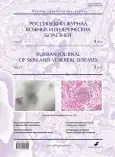Исследование эффективности программ автоматизированной диагностики меланомы кожи с применением технологий искусственного интеллекта
- Авторы: Сергеев В.Ю.1, Сергеев Ю.Ю.1, Тамразова О.Б.2, Никитаев В.Г.3, Проничев А.Н.3, Сергеева М.А.4
-
Учреждения:
- ФГБУ ДПО «Центральная государственная медицинская академия» Управления делами Президента Российской Федерации
- ФГАОУ ВО «Российский университет дружбы народов»
- ФГАОУ ВО «Национальный исследовательский ядерный университет «МИФИ»
- ФГАОУ ВО «Первый Московский государственный медицинский университет имени И.М. Сеченова» Минздрава России (Сеченовский Университет)
- Выпуск: Том 23, № 5 (2020)
- Страницы: 288-292
- Раздел: ДЕРМАТООНКОЛОГИЯ
- URL: https://journals.rcsi.science/1560-9588/article/view/52794
- DOI: https://doi.org/10.17816/dv52794
- ID: 52794
Цитировать
Аннотация
АКТУАЛЬНОСТЬ. Исследование продолжает ряд публикаций, посвящённых эффективности машинного распознавания дерматоскопических изображений меланомы кожи. В некоторых работах отечественных и зарубежных авторов сообщается о достижении высокой чувствительности и специфичности автоматизированной диагностики опухолей кожи. Существенные различия публикуемых данных могут быть результатом как применения разных алгоритмов, так и использования разных групп новообразований кожи для расчёта показателей точности.
МАТЕРИАЛЫ И МЕТОДЫ. Сравнивали точность диагностики меланомы кожи двумя автоматизированными системами искусственного интеллекта.
РЕЗУЛЬТАТЫ. Алгоритм на основе свёрточной нейронной сети улучшил общую точность диагностики на 7% по сравнению с алгоритмом без глубокого обучения, при этом показатель точности составил 78%. Предоставлен исходный набор из 100 использованных дерматоскопических изображений для самостоятельной оценки применимости полученных данных при знакомстве с имеющимися системами искусственного интеллекта.
ЗАКЛЮЧЕНИЕ. Обозначены главные недостатки и возможные пути совершенствования автоматизированной диагностики опухолей кожи на основе цифровой дерматоскопии.
Полный текст
Открыть статью на сайте журналаОб авторах
Василий Юрьевич Сергеев
ФГБУ ДПО «Центральная государственная медицинская академия» Управления делами Президента Российской Федерации
Автор, ответственный за переписку.
Email: vasesergeevu@gmail.com
ORCID iD: 0000-0001-8487-137X
кандидат медицинских наук, доцент кафедры дерматовенерологии и косметологии
Россия, МоскваЮ. Ю. Сергеев
ФГБУ ДПО «Центральная государственная медицинская академия» Управления делами Президента Российской Федерации
Email: vasesergeevu@gmail.com
ORCID iD: 0000-0002-4193-1579
Россия, Москва
О. Б. Тамразова
ФГАОУ ВО «Российский университет дружбы народов»
Email: vasesergeevu@gmail.com
ORCID iD: 0000-0003-3261-6718
Россия, Москва
В. Г. Никитаев
ФГАОУ ВО «Национальный исследовательский ядерный университет «МИФИ»
Email: vasesergeevu@gmail.com
ORCID iD: 0000-0002-4349-3023
Россия, Москва
А. Н. Проничев
ФГАОУ ВО «Национальный исследовательский ядерный университет «МИФИ»
Email: vasesergeevu@gmail.com
ORCID iD: 0000-0003-0443-8504
Россия, Москва
М. А. Сергеева
ФГАОУ ВО «Первый Московский государственный медицинский университет имени И.М. Сеченова» Минздрава России (Сеченовский Университет)
Email: vasesergeevu@gmail.com
ORCID iD: 0000-0003-0292-5878
Россия, Москва
Список литературы
- Мелерзанов А.В., Гаврилов Д.А. Диагностика меланомы кожи с помощью сверточных нейронных сетей глубокого обучения // Врач. 2018;29(6):31-3. doi: 10.29296/25877305-2018-06-06.
- Haenssle H.A., Fink C., Schneiderbauer R., Toberer F., Buhl T., Blum A., et al. Man against machine: diagnostic performance of a deep learning convolutional neural network for dermoscopic melanoma recognition in comparison to 58 dermatologists. Ann Oncol. 2018;29(8):1836-42. doi: 10.1093/annonc/mdy166.
- Szegedy C., Vanhoucke V., Ioffe S., Shlens J., Wojna Z. Rethinking the Inception Architecture for Computer Vision. 2016. IEEE Conference on Computer Vision and Pattern Recognition (CVPR). 2016;2818-26. doi: 10.1109/CVPR.2016.308.
- Haenssle H.A., Fink C., Toberer F., Winkler J., Stolz W., Deinlein T., et al. Man against machine reloaded: performance of a market-approved convolutional neural network in classifying a broad spectrum of skin lesions in comparison with 96 dermatologists working under less artificial conditions. Ann Oncol. 2020;31(1):137-43. doi: 10.1016/j.annonc.2019.10.013.
- Fink C., Blum A., Buhl T., Mitteldorf C., Hofmann-Wellenhof R., Deinlein T., et al. Diagnostic performance of a deep learning convolutional neural network in the differentiation of combined naevi and melanomas. J Eur Acad Dermatol Venereol. 2020;34(6):1355-61. doi: 10.1111/jdv.16165.
- Winkler J.K., Sies K., Fink C., Toberer F., Enk A., Deinlein T., et al. Melanoma recognition by a deep learning convolutional neural network-performance in different melanoma subtypes and localisations. Eur J Cancer. 2020;127:21-9. doi: 10.1016/j.ejca.2019.11.020.
- Phillips M., Marsden H., Jaffe W., Matin R.N., Wali G.N., Greenhalgh J., et al. Assessment of accuracy of an artificial intelligence algorithm to detect melanoma in images of skin lesions. JAMA Netw Open. 2019;2(10):e1913436. doi: 10.1001/jamanetworkopen.2019.13436.
- Cui X., Wei R., Gong L., Qi R., Zhao Z., Chen H., et al. Assessing the effectiveness of artificial intelligence methods for melanoma: A retrospective review. JAAD. 2019;81(5):1176-80. doi: 10.1016/j.jaad.2019.06.042.
- MacLellan A.N., Price E.L., Publicover-Brouwer P., Matheson K., Ly T.Y., Pasternak S., et al. The Use of Non-Invasive Imaging Techniques in the Diagnosis of Melanoma: A Prospective Diagnostic Accuracy Study. J Am Acad Dermatol. 2020:S0190-9622(20)30559-4. doi: 10.1016/j.jaad.2020.04.019.
- Sergeeva M., Sergeev V. On the Russian advances in global teledermoscopy. Oral and Poster Presentations from the XII International Congress of Dermatology April 18-22, 2017. Buenos Aires, Argentina. Abst. 0241. Inter J Dermatol. 2017;56:1268-9. doi: 10.1111/ijd.13720.
- Neretin E.Yu., Sergeev V.Yu. Use of machine vision in the dermatoscopic diagnosis of melanoma. Dermatol Pract Concept. 2015;5(2):137-270.
- Сергеев В.Ю., Сергеев Ю.Ю., Тамразова О.Б., Никитаев В.Г., Проничев А.Н. Вопросы внедрения современных методов автоматизированной диагностики новообразований кожи в клиническую практику // Медицинский алфавит. 2020;(6):76-8. doi: 10.33667/2078-5631-2020-6-76-78.
- Сергеев В.Ю., Сергеев Ю.Ю., Тамразова О.Б., Никитаев В.Г., Проничев А.Н. Автоматизированная диагностика новообразований в дерматологии с применением дистанционных технологий // Медицинская техника. 2019;(3):32-3.
Дополнительные файлы






